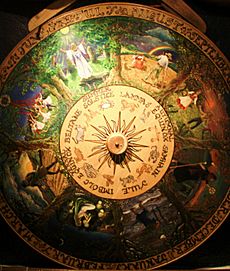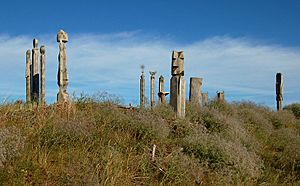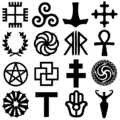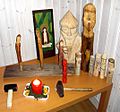Modern paganism facts for kids
Modern paganism, also known as contemporary paganism or neopaganism, is a group of religions inspired by the ancient beliefs of people in Europe, North Africa, and the Near East before Christianity. These religions are very different from each other, so they don't all share the same beliefs, practices, or holy books.
Many modern pagans look to old stories, folklore, and historical records to guide them. Some want to bring back ancient religions as accurately as possible. Others create new spiritual paths that mix old pagan ideas with other beliefs. For example, some groups like Heathenry (Germanic) or Hellenism (Greek) try to rebuild historical religions. Other groups, like Wicca or neo-Druidry, blend different ideas.
Many pagans believe in many gods and goddesses (this is called polytheism). They also often believe that nature has a spirit (this is called animism) or that everything in the universe is divine (this is called pantheism). Some modern pagans are even atheists, meaning they don't believe in gods, but they still follow pagan values and ideas.
Contents
What does "Paganism" mean?
Defining Modern Paganism
It can be tricky to define "modern paganism" because there are so many different kinds! Most experts see it as a wide collection of different religions, not just one single religion. Think of it like how "Abrahamic religions" includes Christianity, Judaism, and Islam – they are all different but share some roots.
Modern paganism is about new religious traditions that are inspired by the old belief systems of Europe, North Africa, and the Near East before Judaism, Christianity, and Islam became common. Even though they are diverse, they often share a common connection to nature and ancient ways.
Why the name "Pagan"?
The word "pagan" originally came from Christians who used it to describe people who weren't Christian. But modern pagans have taken this word back and use it with pride! It's a way for them to show they are different from Christian-dominated society and to honor the ancient cultures of Europe.
Some people prefer "neopaganism" because "neo-" means "new," showing that these are modern religions, not exactly the same as the ancient ones. However, many pagans don't like "neo-" because they feel a strong connection to their ancient roots. To avoid confusion, many experts now use "modern paganism" or "contemporary paganism."
Different Kinds of Paganism
Focus on Culture or Open to All?
Some pagan groups focus on a specific culture or region, like ancient Norse or Celtic traditions. Sometimes, these groups might only allow people from a certain ethnic background to join. However, it's important to know that most modern pagan groups are open to people of all backgrounds and ethnicities. They believe that the gods and goddesses can call anyone to worship them, no matter where they come from.
While there are some groups that have nationalist or even racist ideas, these are generally seen as a small part of the modern pagan movement and are often rejected by the wider pagan community. Most pagans believe in being open, accepting, and respectful of everyone.
Recreating the Past or Blending New Ideas?
Modern pagan groups can be seen on a spectrum:
- Reconstructionists try to bring back ancient religious traditions as accurately as possible. They study historical records and old texts to understand how people worshipped in the past. Examples include Heathenry (Germanic) or Hellenism (Greek).
- Eclectic pagans take inspiration from the past but freely mix traditions from different areas, peoples, and time periods. They don't try to perfectly recreate old rituals. Wicca and Druidry are examples of eclectic paths.
Even within these groups, there can be some mixing. For example, some Wiccans might focus more on a specific cultural link, like Norse Wicca.
How Modern Paganism is Different from Ancient Beliefs
Even though modern paganism is inspired by old beliefs, it's not exactly the same as the ancient traditions. Modern paganism is a new religious movement that has developed in recent times. It blends historical inspiration with new ideas and creativity.
What Pagans Believe
Pagan beliefs and practices vary a lot, but some core ideas are common to many groups.
Many Gods and Goddesses
Most pagans believe in and honor many gods and goddesses. These deities are often linked to nature, different cultures, or human feelings. They are usually seen as wise and powerful, but also as having human-like qualities.
Some pagans see these deities as real beings, while others see them as symbols or ideas that exist within the human mind. Many pagans believe that having a view with many gods is good for society because it encourages freedom, diversity, and tolerance. This helps different pagan groups get along well.
Pagan religions often include female deities, which is a big difference from religions like Christianity or Islam. Many pagans want to include the female side of the divine in their worship.
Nature and Interconnectedness
A key belief for most pagans is that the universe is all connected. They often believe that divinity is part of nature itself. This means that gods and goddesses are not separate from the natural world but are found within it.
Many pagans also believe in animism, which means that everything in the universe has a life force or spiritual energy. Some believe that specific spirits live in natural places like rocks, plants, trees, and animals. Pagans often try to communicate with these spirits.
Honoring Nature

All pagan movements strongly emphasize the idea that nature is divine. They believe that humans are part of the natural world and are connected to all life and the Earth itself. Because of this, places of natural beauty are often considered sacred and are ideal for rituals.
Pagans often believe that different lands and cultures have their own natural religions, and that there are many ways to understand divinity. They usually reject the idea that only one religion is correct.
Many pagans are also very concerned about protecting the environment. They often see the Earth as a Mother Earth, sometimes called Gaia.
Pagan Practices
Rituals

Pagan rituals can happen in public or private settings. These rituals often aim to help people feel more aware or shift their mindset. They might use drumming, chanting, singing, dancing, and meditation to achieve this.
Some pagan groups also include a lot of playfulness and humor in their rituals, believing that joy and silliness can be important parts of a spiritual experience.
Many pagans perform worship at home, offering things like bread, flowers, milk, or wine to images of deities. They might also say prayers, sing songs, and light candles or incense. Unlike some ancient religions, animal sacrifice is very rare in modern paganism.
Festivals

Pagan public rituals often follow the seasons and agricultural cycles. While ancient festivals varied across Europe, many modern pagans celebrate common events like the summer solstice (longest day) and winter solstice (shortest day), as well as the start of spring and harvest time. In Wicca, there's a "Wheel of the Year" with eight seasonal festivals.
Magic
Many modern pagans believe in and practice magic or spells. They often see magic as a way to make changes happen in line with their will or intentions. It's often understood as a way to change one's own consciousness or influence events.
Wiccans, neo-Druids, and other pagan witches often use magic in their practices.
A Brief History of Modern Paganism
Modern paganism has roots in the 18th and 19th centuries, when people became more interested in European folk customs, ancient literature, and mythology. The Romantic movement, which valued emotion and nature, also played a role.
The decline of Christianity in some areas and greater religious freedom allowed people to explore different spiritual paths. In the 1960s and 1970s, modern paganism really started to grow, with new forms like Wicca becoming more visible. The internet in the 1990s helped these movements spread even faster.
Types of Pagan Paths
Reconstructionist Paths

These groups try to rebuild specific ethnic traditions based on old folklore, songs, and historical records. They aim to preserve and revive the beliefs of ancient cultures.
- Germanic Heathenry: Based on the historical religions of Germanic-speaking Europe, like Norse mythology.
- Celtic Reconstructionism: Focuses on the ancient Celts.
- Slavic Native Faith: Revives the beliefs of ancient Slavic peoples.
- Hellenism: Inspired by ancient Greek religion.
- Kemetism: Based on ancient Egyptian religion.
Eclectic Paths
These groups draw inspiration from many different sources and blend them together.
- Wicca: The largest and most well-known form of modern paganism. It often involves honoring a God and a Goddess, and practicing magic. It was influenced by ceremonial magic, folklore, and Romantic literature.
- Goddess Movement: Focuses on the worship of a singular Goddess, emphasizing the sacredness of the female form and women's experiences.
- Neo-Druidry: The second-largest pagan path, inspired by the ancient Celtic priests called Druids. Many groups practice rituals at ancient sites like Stonehenge.
How Many Pagans Are There?
It's hard to get exact numbers for pagans because many keep their religion private to avoid discrimination. Also, paganism is very decentralized, and many people practice alone. However, it's estimated that there are over a million pagans in the United States and around 250,000 in the United Kingdom. The numbers seem to be slowly growing.
Paganism in Society
How People Become Pagan
Most pagans don't try to convert others. Instead, people usually find paganism through friends, books, articles, or websites. Many pagans say they felt a connection to these ideas even before they knew about the movement, as if they were "always pagan" and just found a name for their beliefs.
People are often drawn to paganism because of its beauty, sense of imagination, intellectual satisfaction, personal growth, support for environmentalism or feminism, and the feeling of freedom it offers.
Diversity in the Pagan Community
The pagan community is quite diverse in terms of people's jobs and backgrounds. Many pagans are well-educated and enjoy reading a lot. While many pagans in North America and Europe are white, the community is becoming more diverse.
Paganism generally supports equality for all genders. However, there can be discussions within the community about how gender is understood, especially regarding transgender people. Most pagan groups are very accepting of LGBT people, offering a welcoming space where many feel they belong and can connect with others. Some groups are even specifically for LGBT individuals.
Paganism and Other Beliefs
Modern paganism has some similarities with the New Age movement, but they are also different. New Age often focuses on a better future and sees all religions as the same, while paganism looks to the past and emphasizes the unique qualities of polytheistic religions. Pagans also tend to be more interested in magic and witchcraft than New Age followers.
Some pagans feel a connection to Hinduism because both have roots in ancient Indo-European cultures. They sometimes see Hinduism as a spiritual relative.
Challenges and Understanding
Pagans sometimes face prejudice and opposition, especially from some conservative Christian groups. This can lead to discrimination, so many pagans choose to keep their religion private.
Experts who study religions have started to pay more attention to modern paganism, holding conferences and publishing journals about it. This helps people understand the movement better.
Images for kids
See also
 In Spanish: Neopaganismo para niños
In Spanish: Neopaganismo para niños
















